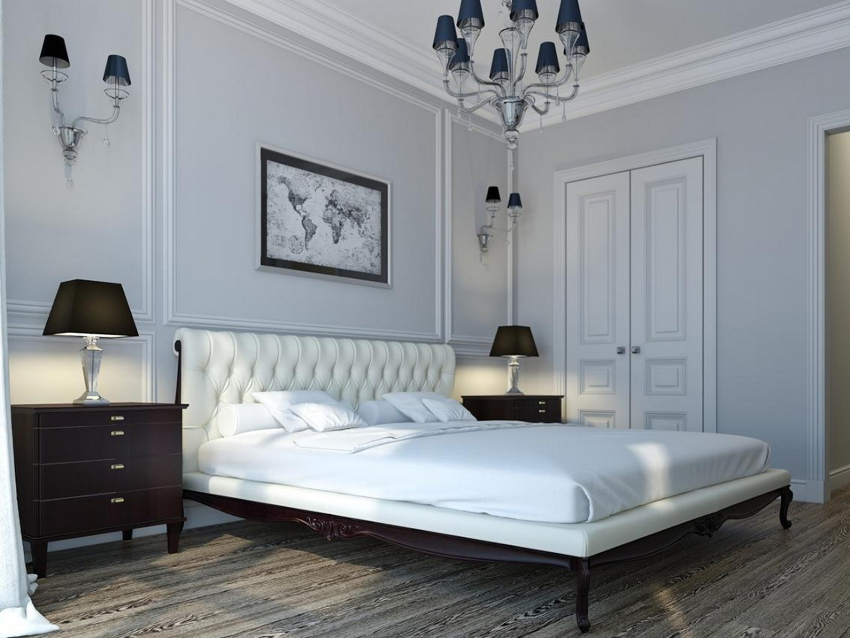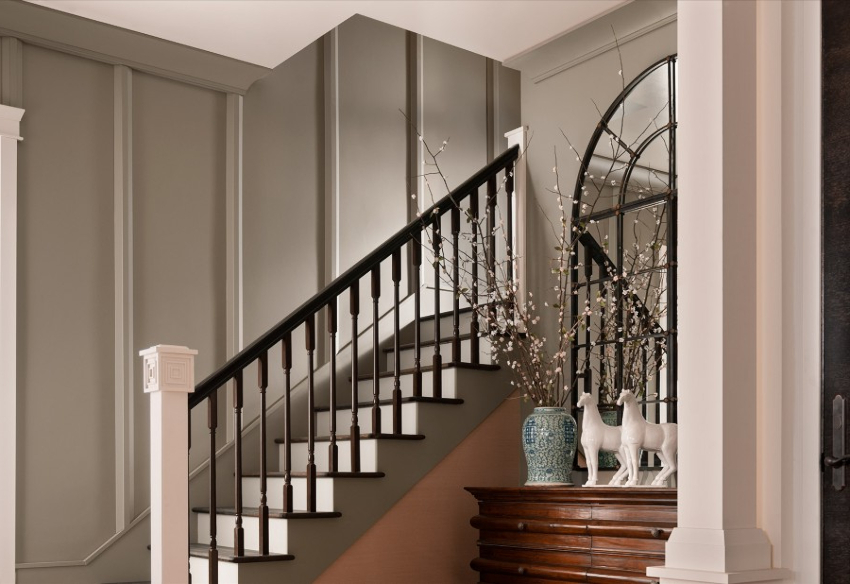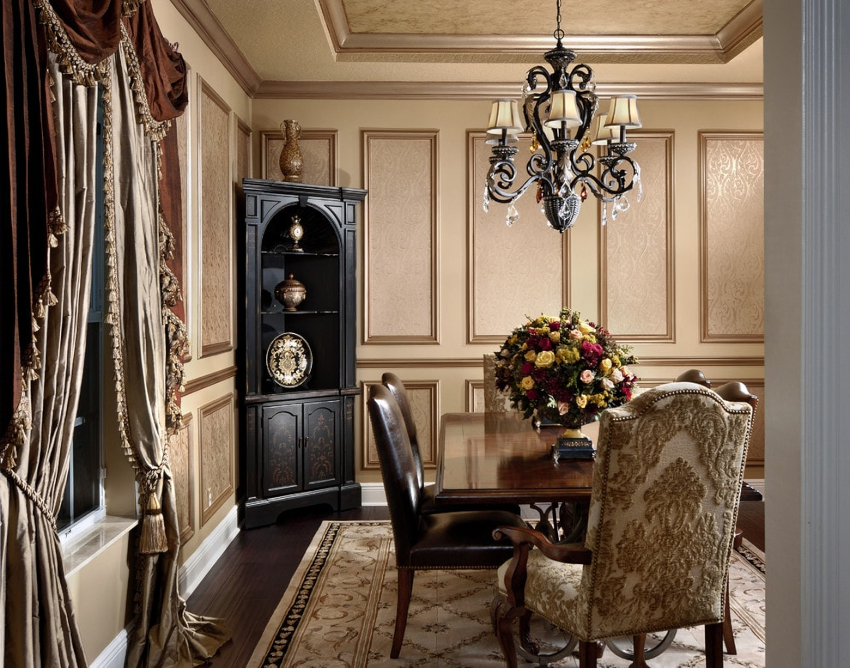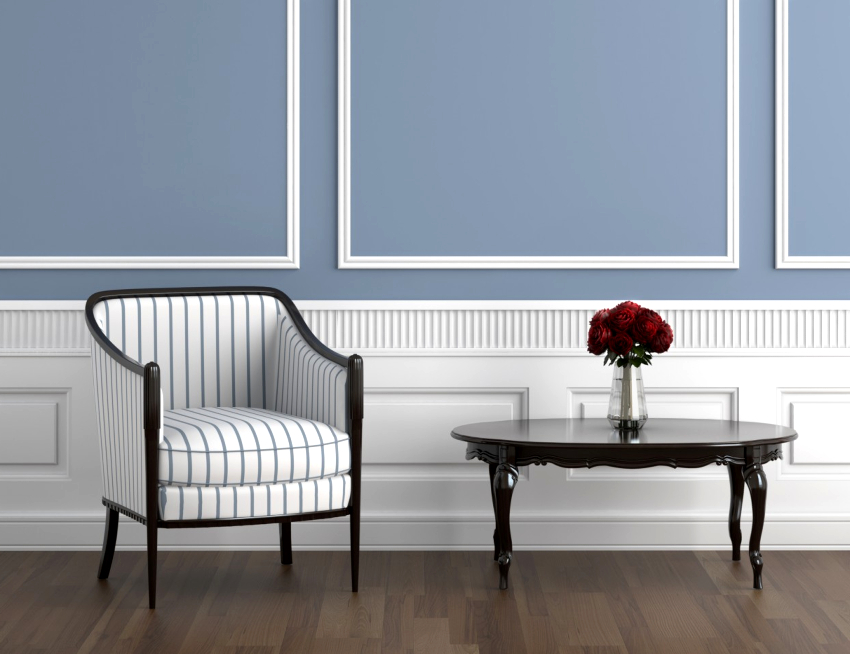Much attention is paid to wall decoration in modern interiors. Often, home and apartment owners strive to add stylish and bohemian forms to the interior. This can be done using classic and time-consuming stucco molding, or you can use a more affordable option - apply moldings to the wall. What kind of material is it, what is it made of and how is it used in decor? The answers to these questions can be found below.
Content [Hide]
- 1 Functional and practical purpose of wall moldings
- 2 Species variety of decorative moldings for walls
- 3 Materials for the manufacture of moldings: features of use in wall decor
- 4 Variants of using moldings on the walls in the interior: photos of original solutions
- 5 How to glue moldings on the wall: choosing a mounting method
Functional and practical purpose of wall moldings
Wall molding is a decorative detail in the form of a volumetric strip, which is used to mask flaws, zoning a room by dividing different types of finishing materials. Beautiful embossed patterns on the walls create an original interior.
Moldings, due to the variety of materials of manufacture and a wide range of applications, have become especially popular in recent years. The main function of such parts is their decorative effect. Decorating the walls in this way helps create a sophisticated environment while highlighting the decor and design elements. In addition, moldings perform a number of secondary, but no less important functions, in particular:
Conspiracy. Decorative strips help to skillfully hide imperfections on the walls or mask the borders of a secret door. Decorating with moldings will help divert attention from irregularities on the wall or errors in the corners.
Delimitation of the premises into functional zones. Decorating the wall with moldings will allow you to separate the part of the room with decorative plaster finishing from the other part where the wall is covered with textured wallpaper.

It is easy to care for the moldings on the walls, it is enough to wipe them with a damp cloth or sweep the dust with a broom
Very often, designers use such decor in order to create original compositions where one of the walls is highlighted, or in order to smooth out the contrast in color transitions, as well as to mask the joints. In addition, decorative moldings are used to create panels or photo frames.
The main advantages of using moldings in the interior
As mentioned above, interior moldings are not only decorative, but also of practical value. They are lightweight and easy to install. You can use them on different surfaces. Looks good in a variety of interior styles.
Useful advice! Decorating walls with moldings to create exquisite patterns on the walls is much more affordable than traditional plaster molding, which costs several times more and takes a lot of time to install. If everything is done in accordance with the instructions, then visually these two types of decor cannot be distinguished.
Based on the list of functions that these decor items perform, a fairly wide range of their advantages can be distinguished:
- They mask surface imperfections. Embossed details on the wall will perfectly hide the damage and help smooth the transition between materials of different texture.
- A smooth transition in wall decoration with materials that contrast in color. This advantage of moldings is provided by their light color. They can be coated with paint of various types and colors.
- Affordable price. Modern manufacturers offer a variety of materials that have different textures and costs. The most popular are polyurethane moldings, which are characterized by a low price and excellent wear resistance.
- Simplicity of the process of decorating walls with moldings. The flat side of the wrong side allows for reliable fastening of the product to various surfaces. To do this, you just need to apply glue and lean the molding against the wall, holding for a few seconds.
- Ease of care. It is enough to wipe the molding with a damp cloth or sweep away dust with a special broom.
Species variety of decorative moldings for walls
Taking into account the desires of consumers, as well as the demand in the market, manufacturers produce moldings of various types. There are several classifications of this popular material used for decorating walls and ceilings. Moldings are distinguished by structure, shape, plasticity, scope, type of material used and nature of painting.
In particular, in terms of shape and size, moldings can be raised or flat. The most popular model is considered to be a product up to 240 cm long. At the same time, there is no standard width, just like the minimum or limited sizes of slats. The shape can also be completely different.
From the point of view of the plasticity of the material, flexible and solid moldings are distinguished. At the same time, it should be noted right away that the first type is much more practical, but the price is also significantly higher, so you should seriously think about the advisability of purchasing them.
The moldings on the walls in the interior can be colored, monochromatic and painted. The latter option is the most popular due to the following advantages:
- the ability to divide walls into zones;
- the ability to create a color accent;
- selection of colors in accordance with the colors of the base material.
Depending on the purpose, the products are divided into the following types:
- ceiling moldings;
- wall-mounted;
- platbands for doors and windows;
- frames for mirrors;
- skirting boards;
- cornices;
- wall panels.
In addition, there are separate decorative elements for arches, windows, furniture.
A separate subspecies of moldings are slot strips, which are used as connecting elements between the bathroom and the wall.
Useful advice! Colored strips should be applied very carefully so that decorative wall moldings in the interior do not create a variegated picture due to an excessive abundance of shades.
Materials for the manufacture of moldings: features of use in wall decor
One of the types of classification of moldings provides for the raw materials used in the manufacture. Both light and rather weighty materials are used here. How these or those models look in different interiors can be judged by the photo of moldings on the walls, and the data provided in the table testify to the advantages and disadvantages of all materials.
| Material used | Advantages | disadvantages |
| foam moldings | low price; ease; easy installation | used to decorate perfectly flat surfaces; high level of fire hazard; toxicity; easily damaged |
| wooden planks | environmental friendliness; the possibility of painting; ease of cleaning; durability; strength | weightiness; the complexity of installation with additional fastening; the need for treatment with special products to protect against pests |
| gypsum products | the ability to choose textures and patterns; strength; high aesthetic qualities; able to highlight different styles | large mass; high price; the complexity of installation; do not fit into the decor of a small apartment |
| polyurethane wall moldings | small weight; durability; ease of installation; flexible surface that allows you to decorate uneven surfaces with curves; affordable price; wide range of models | low environmental safety |
| polystyrene | moisture resistance; the possibility of painting; ease; low price | low elasticity; poor resistance to damage |
| metal moldings for walls | strength; durability; originality | inflexible; fit only in modern styles |
| moldings made of plastic | water resistance; wide range of colors and shapes | impossible to apply paint; toxicity; low strength |
Wide scope of application of polyurethane moldings
Thanks to modern technology, a material as easy to use as polyurethane has been invented. It has become an excellent analogue of traditional plaster, with which you can easily recreate classic lines in the design of different interiors.
Flexible polyurethane moldings are of particular value. In their manufacture, rubber is used, which gives the product the necessary qualities. This is an excellent solution for decorating walls with radius and curved surfaces: such a bar can be easily bent in any direction and fixed in the desired position.
Polyurethane moldings will also help hide minor blemishes. They are used to decorate arches, columns, curved walls and cornice ceilings. Installing moldings between the walls will eliminate unevenness. This also applies to doorways and mirrors.
Interesting to know! Moldings made of marble, plaster or wood are quite rare in modern construction. They are used mainly for the restoration of interiors of historical and other buildings in order to preserve their authenticity. Such products are not only expensive, but also require special attention in terms of care.
Most often, polyurethane decor elements are used in interior design in a classic style. At the same time, a variety of plank options and design approaches make it possible to successfully use them in other stylistic directions. In interior decoration, such products will ideally fit into different places and surfaces.
Application of polyurethane molding
Due to its flexibility, polyurethane moldings can be used in a wide variety of places. When decorating ceilings, they can be used to create whole compositions. This does not require the help of a specialist. This option is especially relevant in the event that the plaster stucco molding is not affordable, and the flat ceiling is bored. One of the areas of successful use of polyurethane molding is as a ceiling plinth.
The use of polyurethane strips will help create various patterns, ornaments on the ceiling, and zone the room. To this end, it is enough to apply the markings and attach the parts along the contour using special glue for polyurethane moldings.
On the walls, polyurethane molding is used in a number of options:
- in the design of doorways;
- in a combination of a number of elements, decorating the mirror frame, door and platbands in the same design;
- as the creation of a false window on a large wall by framing photowall-paper covered with plexiglass.
Details from polyurethane will be an excellent solution for creating decor on furniture. For example, you can give new life to an old wardrobe by framing it with moldings and painting it with silver or gilding. With their help, you can make frames for paintings, mirrors and arches - this is another good option for using polyurethane moldings for wallpaper. A wide selection of products is provided by a variety of patterns and color combinations. Particularly impressive are the wallpaper moldings on the wall where different types of wallpaper are delimited.
Related article:
Plastic panels for walls: photos, types and methods of installation
Installation of plastic wall panels on wood and metal crate using moldings.
Variants of using moldings on the walls in the interior: photos of original solutions
Moldings are used in the design of different rooms and functional areas. The most common is the use of moldings on the walls in the interior of the living room. Photos, of which there are many on the Internet, clearly demonstrate this. At the same time, experts recommend adhering to the following rules:
- In low-ceilinged rooms, it is best to avoid decorating ceilings with wide, contrasting ceiling plinths. Here laconic material will be more appropriate to match the ceiling.
- In small living rooms, narrow small slats look great, and in spacious ones - wide and massive.
- Moldings should fit perfectly into the overall style of the interior and blend harmoniously with the entire environment.
- It is better to choose decorative elements in opposite proportions. Low ceilings will go well with vertical narrow moldings on the wall, and in a room with high ceilings, horizontal panels are appropriate.
Useful advice! It is necessary to use colored moldings in dosage so that various color shades do not oversaturate the interior.
These guidelines are also relevant when applying wall moldings in bedrooms. But in the design of kitchens, the use of this type of decoration is excluded, which is primarily associated with practicality, in order to avoid the accumulation of dirt and carbon deposits on convex elements.
Wall decor with moldings: combination with other materials
Moldings go well with various finishing materials, in particular:
- decorative plaster;
- varnish and paint;
- wallpaper;
- elements made of wood and MDF.
The use of moldings allows you to successfully zone the space, creating different geometric shapes and shapes. For example, wallpaper molding on the walls will help to highlight the individual sections textured. You can simply use different paint colors if you are using paintable wallpaper. This combination of materials makes it possible to simulate panels.
Now the trend is a combination of coatings, different not only in color and texture, but also in composition. For example, the transition from a painted wall in the kitchen area to a wall covered with wallpaper in the hall will brighten up the moldings perfectly. In this case, they will become an indispensable tool in zoning rooms and differentiating one material from another.
To create a design in a modern style, you should choose straight, strict panels, and elements with stucco are ideal for decorating an interior in a luxurious classic style. In this case, moldings are often used for interior doors in the form of platbands. The harmonious combination will ensure the selection of planks, doors and skirting boards in the same tone.
Molding frames will allow you to visually enlarge small windows. To do this, you need to perform one simple but successful trick - cover the entire area with light curtains, and not just the area where the windows are placed.
The competent creation of geometric compositions from moldings will help to refresh the room. Before gluing the moldings to the wall with wallpaper, carefully think over the arrangement of the sections and the furniture arrangement. This design is more typical of the classics.
How to glue moldings on the wall: choosing a mounting method
In the sections discussed above, it was said not only about the wide scope of application of moldings, but also about their varieties in shape, materials, texture. It is important to note that each type requires special installation conditions and can be mounted in several ways.
The most commonly used adhesive composition. The most commonly used silicone adhesive. It can be used to securely fix moldings made of plastic, rubber and metal on a flat surface. For the same purpose, liquid nails are used, especially if the surface is not perfectly flat or has pores.
Almost all materials from which moldings are made are flexible, with the exception of products made from natural materials such as metal or wood. Therefore, such strips must be glued along clear contours, and neat cuts are made in places of bends.
Useful advice! In different styles, graceful strips will be appropriate as frames for decor items: mirrors, photographs, paintings or lighting fixtures. This is evidenced by the many photos of moldings in interiors decorated in different styles.
An excellent solution in the dilemma of choosing products and fixing is the use of self-adhesive moldings. The main condition for their successful use is the need to glue them onto perfectly cleaned and dry surfaces. The protective tape begins to be removed directly during the gluing process, removing it by centimeters.
How to glue moldings on the wall: the nuances of work
Actually, the installation process is quite quick and simple - it is enough to follow a clear sequence of actions and follow several rules, including the following:
- before gluing the moldings to the wall, it is necessary that they lie in the room for at least 24 hours in order to adapt the material to humidity and air temperature;
- strictly special adhesive mixtures or liquid nails are used for installation;
- in the event that the moldings are attached to concrete walls, then acrylic glue is used;
- to ensure reliable fixation of the panels, they are carefully pressed against the wall and held until they grab;
- in installation, an even installation is important, you should also trim the corners as carefully as possible.
The fastening process itself includes a number of sequential actions and consists of the following stages:
- Preparatory. At this stage, the surface of the wall is covered with plaster and carefully primed. Also, markings are applied to the places of the intended attachment of parts.
- Mounting. This is the main stage during which assembly glue is applied to the strips. You need to start glueing moldings from the corners, moving towards the center of the room.
- Drying. This process will take at least 6 hours. At this time, it is advisable to tackle the masking of the cracks and gaps that have formed between the molding and the wall.An ordinary putty is suitable for this, its excess after drying can be easily removed with sandpaper.
- After gluing the moldings, the entire wall or its selected areas are covered with the selected material. This can be wallpaper, paint, or panels.
Thus, moldings may well be called a universal material that successfully hides flaws in the finish, protects corners or joints from damage, helps to zone a room using various finishing materials or to focus on a specific segment. In addition, the material can perfectly diversify and decorate the interior, giving a new image to the room, adding elements of luxury and grace. At the same time, the installation of molding does not require a lot of time, money and special skills.


















